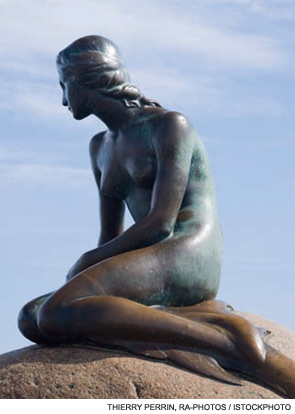
If any doubt about the growth of rheumatology worldwide still lingered, the European League Against Rheumatism (EULAR) congress in Copenhagen this June should have ended it. The meeting was not just big. It was gigantic and filled the sleek new Bella Center on the outskirts of the city. On the grounds of the Bella Center sits a large wind turbine which, while generating the nice green electricity, looked as if it was blowing hoards of rheumatologists through the entrance doors, jetting them into lecture halls and exhibit areas.
The crowding magnified the impression of the meeting’s size. The wide corridors were jammed with people who seemed relentlessly hungry for knowledge. Even in the caverns of the big auditoriums, the sessions were standing room only. On more than one occasion, I had to watch a lecture on a TV monitor outside a barricaded room assiduously guarded by a security officer, albeit a pleasant young woman.

Soggy City
While the record number of attendees led to crowding, the weather was also a big factor keeping people inside the convention center. For the first four days I was there, rain pelted wonderful, wonderful Copenhagen and a fierce wind blasted fusillades of water across the city. We learned later that this was the wettest week in Copenhagen history and one day saw the ninth largest rain accumulation ever recorded in Denmark. People making their way from the subways arrived at the Bella Center drenched, their umbrellas blown apart in cyclonic winds.
I do not know what Danes call this weather, but in the United States, it would be a nor’ easter, although someone said it was like Katrina. With the weather preventing sightseeing and the only attraction around the Bella Center the wind turbine (and how many times can you watch it go around?), people probably logged a record number of CME hours. While standing during a session in a hot, densely packed lecture room, I turned to a friend and suggested that the best way to clear out the place would be to run down the aisle yelling, “The sun is shining, the sun is shining!” The stampede out the door would have been downright dangerous, although I would have finally gotten a seat.
Although the rain dampened the usual excitement of a meeting in a great capital of Europe— indeed, a beautiful gal of a town—I had many vivid impressions of EULAR. I anticipate that the ACR annual meeting in Philadelphia will reprise and amplify these themes.
A meeting with the climatic vicissitudes of the 2009 EULAR congress can’t help but inspire metaphors to describe the state of our specialty. I asked myself “What is the real rheumatology today?”
Plenty to Discuss for Rheumatology
Certainly, as many talks and posters demonstrated, therapy for inflammatory disease is advancing rapidly. Whether a speaker cited remission rates of 50% in the treatment of rheumatoid arthritis (RA) or described new agents to block diseases mediated by interleukin-1, the progress remains very impressive. As treatment moves forward, challenging questions will arise. Can patients in RA in remission stop their DMARDs (any or all)? If they stop therapy and relapse, can remission be recaptured? These are exciting new topics for inquiry that should provide a rich research agenda for the coming years.
A second message I gained from EULAR concerns the potential for innovation in treatment. I would guess that the EULAR congress set a record in the Guinness Book for the number of new targets for immunological intervention presented. I predict that this record will be short-lived and easily broken in Philadelphia. Given the plethora of new targets and the variety of large and small molecules to block their activity, industry and its partners in academia must develop a strategy to select a chosen few agents to move through the pipeline and make sure that optimal treatment reflects the efficacy of agents rather than tradition or the date of regulatory approval. Certainly, it would be a great misfortune if the development of truly breakthrough products stopped because the marketplace look too crowded.
The news from EULAR was not all hygge (a Danish word for their cozy, familial, and tranquil ways). I have always looked at Europe as a place of growth for academic rheumatology as the economy of the continent revived and expanded and the countries of the old Eastern Bloc developed full-fledged market systems. Not surprisingly, Europe is caught in the same economic mess as the United States, and rheumatology is increasingly jeopardized as hospitals cut costs. Our side of the Atlantic also has its share of woes, and those Americans in Copenhagen bemoaned the funding situation. While the stimulus package is great, it will fund only a few of the tens of thousands of applications that have flooded www.grants.gov.

Victims of Our Own Success?
As discussed in this column before, the decline in academic rheumatology, while very troubling, should not be a surprise. It is a direct reflection of success. If new treatments keep the HAQ and Sharp scores down, patients will not need to go to academic medical centers for their care, and research on novel agents will falter. I was recently at a lecture where a representative from the Food and Drug Administration said that there is no longer an unmet need in the treatment of RA. Unmet needs generate the growth of academic units. Met needs do not. Both in the United States and Europe, the leaders of academic rheumatology will have to think long and hard about how to put the spotlight on the unmet needs truly present (e.g., treatment of inflammatory disease in the developing world) and recast the specialty to assure in its place in the big centers.
As the EULAR conference wound down on Saturday, the clouds finally moved out to take up residence some place else in the Baltic. The sun shined brilliantly and the sky turned radiant blue. The conference ended with two summary lectures (kudos to the lecturers for reviewing thousands of abstracts to create such an interesting potpourri).
After a glass of wine with the last stalwarts in the lobby of the Bella Center, I went with friends to the Tivoli Gardens, a glorious amusement park that had its share of misery during World War II. While I sipped a Carlsberg in the warmth of the afternoon sun, members of the Tivoli Guard paraded by in snappy red and white uniforms, playing their fifes and drums as the Demon roller coaster roared through the park.
A meeting with the climatic vicissitudes of the 2009 EULAR congress can’t help but inspire metaphors to describe the state of our specialty. As I took the last sips of my beer, I asked myself, “What is the real rheumatology today?” Is it the Little Mermaid, solitary in a roiling sea pelted by cold rain from dense black clouds? Or, is it a Tivoli guard, a beaming youth giddy with pride as he marches triumphantly with a bearskin helmet?
The wildly contrasting scenes in Copenhagen presented too stark a choice for a metaphor for today’s rheumatology. It is time to go to the ACR meeting in Philadelphia to widen the selection. Who knows? Maybe rheumatology is really Rocky.
Dr. Pisetsky is physician editor of The Rheumatologist and professor of medicine and immunology at Duke University Medical Center in Durham, N.C.